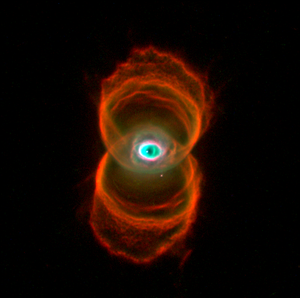astro.wikisort.org - Nebulosa
La nebulosa Reloj de Arena (MyCn 18) es una joven nebulosa planetaria en la constelación de Musca distante 8000 años luz de la Tierra. Fue descubierta por Annie Jump Cannon y Margaret W. Mayall cuando trabajaban sobre el catálogo de Henry Draper.
| Nebulosa Reloj de Arena | ||
|---|---|---|
 | ||
| Datos de observación: Época J2000.0 | ||
| Ascensión recta | 13h 39m 35.12s | |
| Declinación | -67° 22′ 51.5" | |
| Distancia | 8000 al | |
| Magnitud aparente (V) | 13,0 | |
| Tamaño aparente (V) | 25 segundos de arco | |
| Constelación | Musca | |
| Características físicas | ||
| Otras designaciones | ESO 97-1 | |
Se piensa que la forma de la nebulosa Reloj de Arena se debe a la expansión muy rápida de viento estelar sobre una nube de expansión más lenta y que es más densa cerca de su ecuador que de sus polos. Imágenes obtenidas con el telescopio espacial Hubble permiten observar el anillo brillante central, cuyo eje de simetría es totalmente diferente que el del resto de la estructura. Igualmente, la estrella central, responsable de la formación de la nebulosa, aparece claramente descentrada.[1] Estas y otras observaciones se apartan de los modelos teóricos sobre formación de nebulosas planetarias. Los efectos gravitatorios de una estrella acompañante e invisible podrían explicar la compleja estructura de MyCn18.
Véase también
- Lista de nebulosas planetarias
Referencias
На других языках
[de] Stundenglasnebel
Der Stundenglasnebel, auch Sanduhr-Nebel oder MyCn 18 genannt, ist ein planetarischer Nebel im Sternbild Fliege am Südsternhimmel und ist etwa 8.000 Lichtjahre von der Erde entfernt. Die Bezeichnung MyCn 18 stammt von Mayall und Cannon aus dem Jahr 1940.[en] Engraved Hourglass Nebula
The Engraved Hourglass Nebula (also known as MyCn 18[2]) is a young planetary nebula in the southern constellation Musca. It was discovered by Annie Jump Cannon and Margaret W. Mayall during their work on an extended Henry Draper Catalogue (the catalogue was built between 1918 and 1924). At the time, it was designated simply as a small faint planetary nebula. Much improved telescopes and imaging techniques allowed the hourglass shape of the nebula to be discovered by Romano Coradi and Hugo Schwarz in images taken during 1991–1992 at the European Southern Observatory.[3] It is conjectured that MyCn 18's hourglass shape is produced by the expansion of a fast stellar wind within a slowly expanding cloud which is denser near its equator than its poles. The vivid colours given off by the nebula are the result of different 'shells' of elements being expelled from the dying star, in this case helium, nitrogen, oxygen and carbon.- [es] Nebulosa Reloj de Arena
[ru] Песочные Часы (туманность)
Песочные Часы (также известна как MyCn 18) — биполярная планетарная туманность, расстояние до которой составляет порядка 8000 световых лет. До сих пор до конца не ясно, что заставило туманность приобрести такую необычную форму, возможно она сформировалась из плотного газового облака в экваториальной плоскости центральной звезды туманности, которое под влиянием межзвёздного ветра приобрело видимую сейчас форму.Другой контент может иметь иную лицензию. Перед использованием материалов сайта WikiSort.org внимательно изучите правила лицензирования конкретных элементов наполнения сайта.
WikiSort.org - проект по пересортировке и дополнению контента Википедии